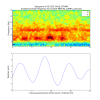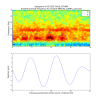According to alog 23420, "When useism is high, however, we have to use a 45mhz blends..." so I've changed all of them on ETMY and ETMX to 45mHz.
Status is that all BSC ISI's are on all 45mHz blend filters.
It appears that changing the blend filters rung up ETMX. I'm trying to get it back. I have the ISI in Isolated Damped, and manually changed GS13 fitlers and ST2 ISO filters and gains to engage ST2 ISO, which has worked, however, I'm at 0.01 gain for the loops when they are typically at 1 for ISO_X, Y, Z, and RZ. I did not engage ISO RX or RY.
- 4:55UTC set ISI to ISOLATED DAMPED
- 5:12UTC set gain to 0.1
- 5:13UTC set gain to 0.01
- 5:35UTC set gain to 0.002
- 5:52UTC set gain to 0.004
- 6:01UTC set gain to 0.5 with a ramp time of 20 minutes
- 6:25UTC set guadian to fully isolated and it appears that that worked
6:44UTC - oscillations come back.















